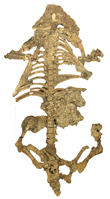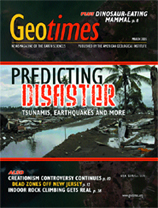
|
|
||||||||||||||||
| |
|||||||||||||||||
|
 Dinosaur-eating
mammal Dinosaur-eating
mammalQuake uplifted Japan Cities at risk from below Evolution battles rage Mother lode of hominid fossils Paleo-Antarctic puzzle Dead zones off New Jersey Rocky debate over early life Submarine hits unmapped mountain TIGER in the sky Geophenomena
Print Exclusive
|
||||||||||||||||
|
Marketing an Asteroid Threat It is tough to tease out real threats and accurate science in a sea of publicity geared toward raising support for research programs. Joseph Richard Gutheinz Political Scene Inside Baseball Rules Congress Scientists need to learn the legislative landscape to successfully maneuver through Capitol Hill. Emily Lehr Wallace Geologic Column Survivors’ Guilt Developing warning systems for the next tsunami disaster may be straightforward, but convincing countries to change their views of natural hazards is more complex. Fred Schwab |
Keiiti Aki: Seismological polymath Trends and Innovations
|
||||||||||||||||
 ON
THE COVER ON
THE COVER Debris still litters the city of Meulaboh on the island of Sumatra, Indonesia, weeks after the Dec. 26 earthquake and tsunami that devastated the region. U.S. Marine Corps photo is by Pfc. Nicholas T. Howes. Background: This image was taken on Dec. 29 — just three days after the tsunami hit Khao Lak, a popular tourist destination on the southern coast of Thailand. The tsunami destroyed most of the area's lush vegetation, beaches and resorts. Photo is courtesy of Space Imaging/CRISP-Singapore. While humanitarian efforts continue throughout the affected Indian Ocean area, world leaders are discussing strategies for warning communities of impending tsunami events. Read more on page 20. |
April: Climate and Society
|
| SUBSCRIBE | CLASSIFIEDS | ADVERTISE | FOR AUTHORS | CONTACT US | ARCHIVE | SEARCH |
 |
Geotimes Home | AGI Home | Information Services | Geoscience Education | Public Policy | Programs | Publications | Careers |